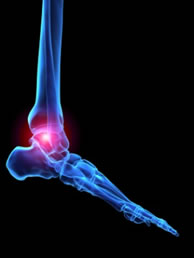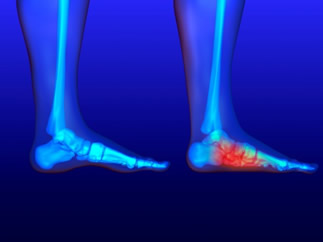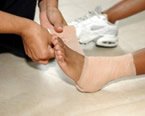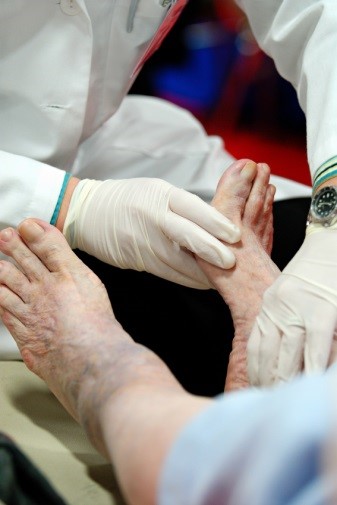January 2016
Facts About Osteoarthritis
 Osteoarthritis is a degenerative disease caused by the continual thinning of cartilage, and once the damage is caused, it becomes permanent. Osteoarthritis is a debilitating issue that affects about 1 in 5 adults who are 45 years or older. It’s important for patients to treat symptoms of osteoarthritis before the condition progresses. Treatment options involve physiotherapy to strengthen the muscles, surgery to replace joints, and wearing proper footwear to help alleviate pain. It’s important for patients to see their podiatrists as soon as they think something is wrong, so that they can receive proper treatment and delay the progression of symptoms.
Osteoarthritis is a degenerative disease caused by the continual thinning of cartilage, and once the damage is caused, it becomes permanent. Osteoarthritis is a debilitating issue that affects about 1 in 5 adults who are 45 years or older. It’s important for patients to treat symptoms of osteoarthritis before the condition progresses. Treatment options involve physiotherapy to strengthen the muscles, surgery to replace joints, and wearing proper footwear to help alleviate pain. It’s important for patients to see their podiatrists as soon as they think something is wrong, so that they can receive proper treatment and delay the progression of symptoms.
Arthritis can be a difficult condition to live with. If you have any concerns about your feet or ankles, contact Dr. Steven Schwartz of Pennsylvania. Our doctor will treat your foot and ankle needs.
Arthritic Foot Care
Arthritis is a joint disorder that involves inflammation of different joints in your body, such as in your feet. Arthritis is often caused by a degenerative joint disease and causes mild to severe pain in all affected areas. On top of this, swelling and stiffness in the affected joints can also be a common symptom of arthritis.
In many cases, wearing ill-fitting shoes can worsen the effects and pain of arthritis. Wearing shoes that have a lower heel and extra room can help your feet feel more comfortable. In cases of rheumatoid arthritis, the arch in your foot may become problematic. Buying shoes with proper arch support that contour to your feet can help immensely.
Alleviating Arthritic Pain
- Exercises that stretch the foot can prevent further pain and injury and increase mobility
- Most of the pain can be alleviated with anti-inflammatory drugs, heat, and topical medications
- Massages can help to temporarily alleviate pain.
It is best to see your doctor for the treatment that is right for your needs and symptoms. Conditions vary, and a podiatrist can help you determine the right method of care for your feet.
If you have any questions please feel free to contact our offices located in Chambersburg and Mcconnellsburg, PA. We offer the newest diagnostic tools and technology to treat your foot and ankle needs.
Arthritic Foot Care
During your lifetime, you will probably walk about 75,000 miles, which is quite a lot of stress to put on your feet. As you get older, the 26 bones and 30 joints in your body will lose flexibility and elasticity. Your foot’s natural shock absorbers will wear down as well. Having arthritis added to this mix only makes matters worse. Your joints will become distorted and inflamed, which is why arthritic foot care needs to be something to think about every day.
When dealing with arthritis, having additional foot complications, such as bunions, hammertoes, or neuroma, can be a serious detriment. To avoid these, buy well-fitting shoes with a lower heel and good support. Arthritis causes you to lose your arch, so having shoes with good arch support is also highly recommended.
Aside from getting good arch support, the shoes need to fit comfortably and properly as well. A good place to start is by leaving a finger width between the back of the shoe and your foot to gauge proper size. It is also helpful to have a square or rounded toe box in the front to provide even more comfort. Another thing to look for is a rubber sole that can provide a cushion and absorb shock as you walk. This adds flexibility to the ball of your foot when you push off your heel to walk.
Exercise is another key aspect of arthritic foot care. Exercise not only strengthens and stretches your muscles and joints, but helps to prevent further injury and pain as well. Stretching the Achilles tendon, the tendon located in the back of your heel, will give you added mobility and reduce pain due to stress. Another thing you can do is massage your feet, kneading the ball of your foot as well as your toes from top to bottom.
Stretching the Achilles tendon is a simple exercise that you can do at home anytime. Lean against the wall with your palms flat against the surface while placing one foot forward, towards the wall, and one foot behind you. Bend your forward knee towards the wall while keeping your back knee locked straight, and make sure both your heels are completely touching the ground at all times. This will stretch your Achilles tendon and calf muscles as well. You will feel the stretch almost immediately. You can also stretch your toes in a couple ways. One involves taking a rubber band and wrapping it around both your big toes while your heels remain together. Then, pull them apart to stretch your big toe. You can also place a rubber band around all the toes of one of your feet. Then, try to separate each individual toe, stretching them all.
A final step you can take to help your arthritis is taking non-steroid, non-inflammatory drugs or topical medicines with capsaicin. Unfortunately, there is no complete way to remove all of your arthritic pain. However, following some of this advice can go a long way in staying as pain-free as possible.
Facts About Flat Feet
 Flat feet refers to a condition in which the arches of the feet have collapsed, causing nearly the entire sole of the foot to come into contact with the floor. A suspected 30 percent of the population has an arch that fails to fully develop in either or both feet. To manage flat feet, a podiatrist may prescribe shoe inserts or custom orthotics to support the fallen arch and ease any pain felt. In other cases, physical therapy may be suggested.
Flat feet refers to a condition in which the arches of the feet have collapsed, causing nearly the entire sole of the foot to come into contact with the floor. A suspected 30 percent of the population has an arch that fails to fully develop in either or both feet. To manage flat feet, a podiatrist may prescribe shoe inserts or custom orthotics to support the fallen arch and ease any pain felt. In other cases, physical therapy may be suggested.
Most arches will develop in children after a certain age. If you have any concerns about your feet or ankles, contact Dr. Steven Schwartz of Pennsylvania. Our doctor will treat your foot and ankle needs.
What are Flat Feet?
Flat feet are a condition in which the arch of the foot is depressed and the sole of the foot is almost completely in contact with the ground. Standing about 20-30% of the population generally has flat feet because their arch never formed during growth.
Conditions & Problems:
Having flat feet makes it difficult to run or walk because of the stress placed on the ankles.
Alignment – The general alignment of your legs can be disrupted, because the ankles move inward which can cause major discomfort.
Knees – if you have complications with your knees, flat feet can be a contributor to arthritis in that area.
Symptoms:
Pain around the heel or arch area
Trouble standing on the tip toe.
Swelling around the inside of the ankle.
Flat look to one or both feet.
Having your shoes feel uneven when worn
Treatment:
If you are experiencing pain and stress on the foot you may weaken the posterior tibial tendon, which runs around the inside of the ankle.
If you have any questions please feel free to contact our offices located in Chambersburg and Mcconnellsburg, PA. We offer the newest diagnostic tools and technology to treat your foot and ankle needs.
Flat Feet
Flatfoot is a foot condition in which the arch of the foot has either partially or totally dropped or has never developed. While it is common in babies and small children, it can become a problem for them in adulthood if the arch never forms. For adults, the development of flat feet can be brought upon by injury, as a result of pregnancy due to increased elasticity, or obesity. Those who have health concerns such as rheumatoid arthritis or diabetes may also be at greater risk for developing the condition.
If you suspect that you have flat feet, it is best to consult your podiatrist. Your foot doctor will examine the suspected foot and observe how it looks while you sit and stand. He or she may take an X-ray to determine how serious the condition is. Some common signs of flatfoot include toe drift, in which the toes and front part of the foot point outward, a short Achilles tendon, and a heel that tilts outwardly while the ankle tilts inward.
Once flatfoot has been diagnosed, your podiatrist may suggest one of several treatment options. Flat feet can be rigid, in which the feet appear to have no arch even when the person is not standing; or flexible, in which the person appears to have an arch while not standing, but once standing the arch disappears. Those with flexible flatfoot may be told to reduce any activities that cause pain and to avoid extended periods of walking or standing. Another suggestion may be weight loss, as excessive weight may be placing pressure on the arches
In few cases, if the condition is severe and all other methods have been exhausted surgery may be required. This is normally avoided, however, due to a lengthy recovery time and high cost.
Arizona Wildcats Kaleb Tarczewski Out for Foot Injury
 Kaleb Tarczewski, senior center for the Arizona Wildcats, has sustained a foot injury and will be out for four to six weeks. The injury is described as a stress reaction and strained muscle. Sophomore Dusan Ristic will be replacing Tarczewski. Tarczewski averages about 57.7 percent shooting and 8.6 points and 7.2 rebounds a game per five games. The Arizona Wildcats won the game against Santa Clara of the Wooden Legacy tournament.
Kaleb Tarczewski, senior center for the Arizona Wildcats, has sustained a foot injury and will be out for four to six weeks. The injury is described as a stress reaction and strained muscle. Sophomore Dusan Ristic will be replacing Tarczewski. Tarczewski averages about 57.7 percent shooting and 8.6 points and 7.2 rebounds a game per five games. The Arizona Wildcats won the game against Santa Clara of the Wooden Legacy tournament.
Sports related foot and ankle injuries need proper treatment before players can go back to their regular routines. If you have any concerns about your feet or ankles, contact Dr. Steven Schwartz of Pennsylvania. Our doctor will treat your foot and ankle needs.
Sport Related Foot and Ankle Injuries
Foot and ankle injuries are a common occurrence when it comes to athletes of any sport. While many athletes dismiss the initial aches and pains, the truth is that ignoring potential foot and ankle injuries can lead to serious problems. As athletes continue to place pressure and strain the area further, a mild injury can turn into something as serious as a rupture and may lead to a permanent disability. There are many factors that contribute to sports related foot and ankle injuries, which include failure to warm up properly, not providing support or wearing bad footwear. Common injuries and conditions athletes face, including:
- Plantar Fasciitis
- Plantar Fasciosis
- Achilles Tendinitis
- Achilles Tendon Rupture
- Ankle Sprains
Sports-related injuries are commonly treated using the RICE method. This includes rest, applying ice to the injured area, compression and elevating the ankle. More serious sprains and injuries may require surgery, which could include arthroscopic and reconstructive surgery. Rehabilitation and therapy may also be required in order to get any recovering athlete to become fully functional again. Any unusual aches and pains an athlete sustains must be evaluated by a licensed, reputable medical professional.
If you have any questions please feel free to contact our offices located in Chambersburg and Mcconnellsburg, PA. We offer the newest diagnostic tools and technology to treat your foot and ankle needs.
Sport Related Foot And Ankle Injuries
Foot and ankle injuries are common among people who participate in sports. Several factors contribute to this. They include failing to stretch or warm up properly, not wearing the proper type of shoe and not taping or providing other types of support for the ankle or foot. The most common foot and ankle injuries suffered by people involved in sports are plantar fasciitis, ankle sprains and Achilles tendon damage or ruptures. If not treated properly, they can lead to permanent disability.
Treating these injuries is relatively simple if they are identified and addressed early. Many athletes dismiss the initial aches and pains associated with injury as just soreness or tired muscles. Their first response is usually to try to work through it. This can lead to serious problems. Many minor injuries are made far more serious when athletes continue to put strain and pressure on them. That attitude can change a mild strain into a serious strain and a minor tear into a rupture. Athletes should have unusual aches and pains evaluated by a skilled medical professional.
Plantar fasciitis is a painful injury. It is inflammation of the plantar fascia, the thick band of tissue running from the heel to the base of the toes. If left untreated, it can lead to a degenerative disease called plantar fasciosis. There are several effective treatments for this ailment. Doctors often prescribe rest, massages, stretching, night splints, physical therapy, anti-inflammatory medication, corticosteroids or surgery, usually in that order. The most effective treatment for plantar fasciitis is orthotics, which offers foot support. Surgery is occasionally used as a last resort, but it comes with the risk of nerve damage and infection and often does not stop the pain.
The Achilles tendon is the largest tendon in the body. It connects the calf muscles to the heel bone. Running, jumping and walking all impact this tendon. Two common injuries to the Achilles tendon are tendonitis and a rupture of the tendon. Tendonitis is inflammation in the tendon often caused by an increase in the amount of stress placed on it. Non-surgical treatments include rest, ice or anti-inflammatory medication. A rupture (tear) of the Achilles tendon can be treated by placing the lower leg in a cast for several weeks or with surgery. Many physicians feel surgery is the better option because it lowers the risk of re-ruptures. Both methods require 4 to 6 months of rehabilitation.
Ankle sprains are the most common sports related foot and ankle injury. A sprain occurs when the ligament holding the ankle bones and joint stretches beyond its normal range. It can be treated non-surgically with a combination of rest, ice wrapped around the joint for 30 minutes immediately after injury, compression by a bandage and elevating the ankle above the heart for 48 hours. This combination is referred to as RICE. Severe ankle sprains in which the ligaments are torn may require reconstructive surgery followed by rehabilitation.
Orthopedic Surgeon Invents Flip-Flops to Treat Plantar Fasciitis
 Plantar fasciitis is felt by about one in ten people, says Dr. Meredith Warner, an orthopedic surgeon located in Baton Rouge. Dr. Warner suggests seeking treatment before the muscle in the heel, called the plantar fascia, starts degenerating. To accommodate the different feet of her many patients who have plantar fasciitis, Dr. Warner created the Healing Sole, a customized flip-flop that helps with treating plantar fasciitis. The Healing Sole is designed to accommodate patients’ feet.
Plantar fasciitis is felt by about one in ten people, says Dr. Meredith Warner, an orthopedic surgeon located in Baton Rouge. Dr. Warner suggests seeking treatment before the muscle in the heel, called the plantar fascia, starts degenerating. To accommodate the different feet of her many patients who have plantar fasciitis, Dr. Warner created the Healing Sole, a customized flip-flop that helps with treating plantar fasciitis. The Healing Sole is designed to accommodate patients’ feet.
Plantar fasciitis can be very painful and inconvenient. If you have any concerns about your feet or ankles, contact Dr. Steven Schwartz of Pennsylvania. Our doctor will treat your foot and ankle needs.
What is Plantar Fasciitis?
Plantar fasciitis is the inflammation of the thick band of tissue that runs along the bottom of your foot, known as the plantar fascia, and causes mild to severe heel pain.
What Causes Plantar Fasciitis?
· Excessive running
· Non-supportive shoes
· Overpronation
· Repeated stretching and tearing of the plantar fascia
How Can It Be Treated?
· Conservative measures – anti-inflammatories, ice packs, stretching exercises, physical therapy, orthotic devices
· Shockwave therapy – sound waves are sent to the affected area to facilitate healing and are usually used for chronic cases of plantar fasciitis
· Surgery – usually only used as a last resort when all else fails. The plantar fascia can be surgically detached from the heel
While very treatable, plantar fasciitis is definitely not something that should be ignored. Especially in severe cases, speaking to your doctor right away is highly recommended to avoid complications and severe heel pain. Your podiatrist can work with you to provide the appropriate treatment options tailored to your condition.
If you have any questions please feel free to contact our offices located in Chambersburg and Mcconnellsburg, PA. We offer the newest diagnostic tools and technology to treat your foot and ankle needs.
Plantar Fasciitis
The plantar fascia is a connective tissue in the heel that stretches the bottom length of your foot. Plantar fasciitis is the inflammation of this connective band, causing heel pain and overall discomfort while walking or standing. Although the condition is completely treatable, traditional methods can take up to a year to start being effective.
Plantar fasciitis is caused by a number of everyday activities, so understanding and assessing the condition is paramount to managing and treating it. One of the most common causes of plantar fasciitis is excessive running, especially with improper fitting or non-supportive shoes. By over exercising and running, the plantar fascia gets overworked and overstretched, eventually causing tears in the tissue and inflammation. Along with improper fitting shoes, over-pronation is a common cause of plantar fasciitis. By not having the right shoes to correct this issue, once again the plantar fascia becomes overstretched and starts to tear, causing the inflammation.
Despite the common causes of plantar fasciitis, there are many different treatment options. For less severe cases, conservative home remedies such as taking anti-inflammatory drugs to alleviate pain, applying ice packs to the bottom of your foot and heel, slowly stretching and exercising your feet to re-strengthen the tissue, and using orthotic devices to overcome issues such as over-pronation are all ways to help manage your plantar fasciitis.
For more severe cases however, there are still things that can be done. Shockwave therapy has become a common solution for plantar fasciitis because it effectively breaks up the tissue on the bottom of your foot via sound waves which facilitates healing and regeneration, allowing you to overcome the chronic pain caused by plantar fasciitis. Even if this doesn’t work, surgery is always a final option. Surgery on the tissue itself can be done to permanently correct the issue and stop the inflammation and pain is your heels.
No matter what the case may be however, seeking the immediate care of your podiatrist is the first and best step to recovery. Even the slightest amount of heel pain could be the first stages of plantar fasciitis and the initial onset of tearing and overstretching of that band of tissue. On top of this, because the tearing of this tissue can be compounded if it remains ignored, it could become a more severe case than it needs to be. The solution to this is early detection and early treatment, so be sure to talk to your podiatrist about the possibilities of plantar fasciitis if you’re experiencing heel pain.

